Born on a low hill in the Val di Chiana that opens to the south towards the filling area, Foiano della Chiana is one of the liveliest agricultural and commercial centers in the valley that extends its vitality also to the surrounding hamlets, such as Pozzo della Chiana. Populated since the sixth century BC, with the proliferation of Etruscan civilization, the center experienced a long period of Roman domination at the end of which, in the dark age of the barbarian invasions, the swamp began to desolate its fertile lands.
The first community, in medieval times, to adopt a citizen statute, declaring itself a free and independent municipality already in 1084, Foiano fell over the centuries under the dominion of Siena, Arezzo and finally Florence. The Florentines rebuilt the walls, giving the entire town the appearance of a real port controlling the swamp.
Testimonies dating back to 1300 pass down that, only thanks to the use of small boats, Foiano was able to communicate with the nearby villages of Castiglion Fiorentino and Cortona.
Theater of the famous battle of Scannagallo, fought in 1554 in the ditches of Pozzo della Chiana, Foiano inextricably links its history to that of Florence first with the Medici government and, subsequently with the Grand Duchy of Lorraine, a dynasty that produced substantial changes in the Chianina Valley, with his swamp reclamation works.
Stressed by the Second World War, the town paid a considerable price in terms of human lives and destruction, so much so that it still hosts the Commonwealth War Cemetery, an English military cemetery, which hosts the soldiers from across the Channel, who died during the local military actions. Cradle of traditions linked to country culture, Foiano is also known in the national limelight for its Carnival, one of the oldest country festivals in Italy, which attracts visitors from all over Tuscany every year.
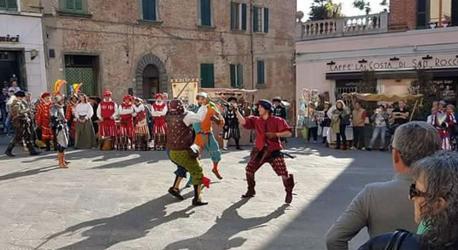
Every year, in April, Foiano della Chiana takes a step back in time, returning to the era of the ancient castles, with a festival that celebrates the local traditions and food and wine products linked to the Easter tradition. The undisputed protagonist is the ciambellino (a ring of crumbly dough made from egg and flour, with a diameter of about 20 cm), an ancient Easter cake of the peasant tradition, which with its shape symbolizes the crown of thorns of Christ on the cross.
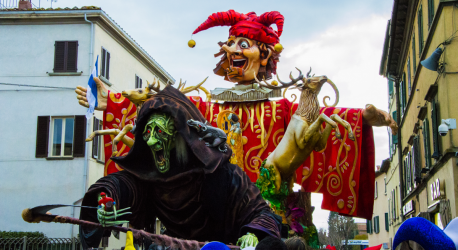
Although its current appearance dates back to the early 1930s, the Foiano Carnival understood as a pagan festival is perhaps the oldest in Italy. Its existence is confirmed by a provision contained in a city statute of 1539, which announced three days of celebrations for the carnival festival. Every year four large allegorical floats, real works of papier-mâché and mechanics made by the Azzurri, Bombolo, Nottambuli and Rustici shipyards, parade in front of a jury made up of international art experts to win the victory and the glories of the carnival people.
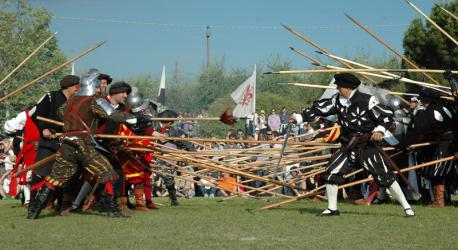
Together with Marciano, Foiano della Chiana was also at the center of the battle of Scannagallo which, in 1554, resolved the clash between Florence and Siena, placing an important step towards the constitution of the future Grand Duchy. Re-proposed through the historical re-enactments promoted by the Scannagallo association, these historical events relive every year among figures, weapons and period clothes for a real dip into the past at the time of the Renaissance.
Set up in the premises of the church of Santa Maria della Fraternita, the Civic Museum of Foiano is today the symbol of the historical-artistic memory of the whole town. A reality that is part of a wider work of protection, conservation and enhancement of the local artistic heritage. The works kept inside the church makes it a special environment. Among these it is impossible not to mention, the altar of Saint Euphemia where there is a glazed terracotta statue depicting the Madonna and Child, attributed to Andrea della Robbia, and a series of canvases made by Giovanni Camillo Sagrestani.
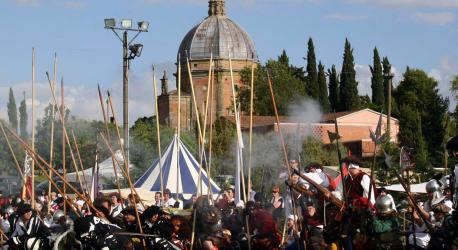
Located in Pozzo della Chiana, the Temple of S. Stefano della Vittoria is a sacred building built by the Grand Duke Cosimo I de 'Medici near the plain of Scannagallo, where the troops of the imperial coalition defeated the Franco-Senese troops during the Siena War. Traditionally attributed to Bartolommeo Ammannati, but recently linked to the professional collaboration between the latter and Giorgio Vasari, the building consists of an interesting brick construction surmounted by a dome covered with lead plates, dedicated to the Roman goddess of Victory in battle.
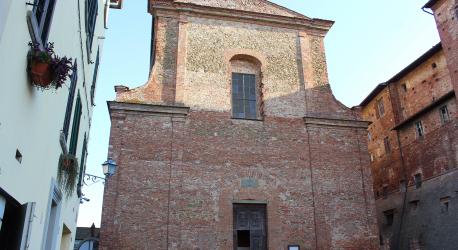
Known more commonly as Collegiata di S. Martino, the Collegiata dei Santi Martino e Leonardo is a sacred building erected in the sixteenth century and renovated during the eighteenth century. Located in the homonymous square, the structure preserves inside some of the most significant works of Tuscan artistic production: from the "Coronation of the Virgin with angels and saints" by Luca Signorelli, dated 1523, to the "Crucifixion" by Orazio Porta, passing through the sixteenth century to the altarpiece with "The Madonna della Cintola" attributed to Della Robbia.
TheAssociated paths of FOIANO DELLA CHIANA






